I’ve been wanting to do a follow-up post on the connection between child slavery and chocolate. In case you missed it, the low-down is here . . . but in a nutshell a BBC documentary revealed that child labor and even child trafficking is rampant in chocolate production, and that chocolate from most mainstream candy companies can be traced back to farms employing (and even buying) children to work in dangerous conditions. For our family, the response to learning this has been to limit our chocolate purchases to fair-trade chocolate, which is a system that ensures that workers are paid and treated fairly. I believe that our purchases have the biggest impact on corporate change. The chocolate companies are well aware of the human rights abuses in the farms they are buying from, but unfortunately it is the profitability that is driving the ship, not ethics. I really do believe that consumers can change things. I think back ten years ago, when organic food was a fringe hippie thing that you could only by at specialty stores. Now, nearly every mainstream grocery store is producing their own line of organic foods. Consumer demand is what drives the market. I realize that everyone is at different levels in terms of how willing they are to make changes. I’ve given ideas below for every level (rated 1-4 stars), from baby-step changes to full-on advocacy. Of course, personally, my hope is that everyone would at least give up mainstream chocolate, because I think it could send a powerful message.
{*} Baby Steps: avoid Hershey’s
If you aren’t quite ready to commit to alternative Halloween chocolate candies, then my recommendation is to purchase products from Mars (e.g. 3Musketeers, Mars, Milky Way, Snickers, Twix) and Kraft (e.g. Cadbury, Green & Black’s, Toblerone). These companies have recently taken basic first steps toward incorporating ethical, sustainable cocoa into their products. Mars has a stated goal of using 10% certified sustainable cocoa this year and an end goal of 100% certified sustainable cocoa by 2020. Kraft has also begun sourcing some of its cocoa sustainably. Keep in mind, though, that these corporations, and most mainstream candy companies, are still far behind when it comes to support for ethical chocolate. It’s likely these companies are using chocolate sourced from child labor. However, Hershey’s seems to be the prime offender. After my last post, I was contacted by one of the Human Rights Organizers at Change.org who alerted me to the #nohersheyhalloween campaign. Along with the International Labor Rights Forum and Green America, Change.org has mounted a huge campaign against Hershey’s over the past few months, calling on them to live up to their promise and start buying certified cocoa. They have collected nearly 47,000 signatures on our petition on Change.org and have also created robust social media and press outreach campaigns to put further pressure on Hershey’s. (I did get connected to the PR person for Hershey’s and posed some questions to her about Hershey’s stance, but I haven’t heard back yet.)
{**} Conscious Shopper: choose chocolate-free candy
If you want to be a little more conscious but aren’t ready to commit to fair trade, you can stick to non-chocolate candy. However, keep in mind that sugar production has it’s own set of human rights abuses. (In fact, when you really do some research, the chocolate industry is only scratching the service of everyday products produced by children). If not buying fair-trade, it’s a good idea to stick to products made in the USA, since our country at least has some laws in place to prevent child labor and worker abuse. Mike and Ikes, Hot Tamales, Neccos, and Clark Bars are examples of US-made candy. 
{***} Socially Responsible Consumer: buy fair-trade or organic
Buying fair-trade is the best way to ensure that chocolate has been ethically sourced, and it also sends a message to mainstream chocolate companies that there is consumer demand for Fair Trade Certified chocolate (which is ultimately what will lead to change). Buying organic is reportedly another way to ensure that your chocolate wasn’t produced by exploited children due to the checks on labor practices organic certification requires. Additionally, organic producers often receive higher (and more stable) payment for their goods than those who don’t use organic methods. The best sources I’ve seen for a variety of socially conscious Halloween shoppers are the Global Exchange Fair Trade Store and the Natural Candy Shop. But since Halloween is just around the corner, here are some ideas for things you might be able to find at local stores. Also, if you are lucky enough to live near a Trader Joe’s, they have a great selection of organic and fair-trade chocolate. 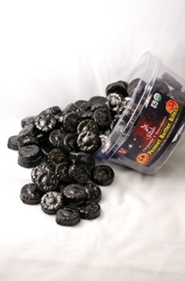 Sjaak’s Halloween Peanut Butter Bites
Sjaak’s Halloween Peanut Butter Bites
Price: 35-43 cents per piece ($33.00 for a 1.5lb tub, about 93 pieces)
Where to buy: Online or select health food stores
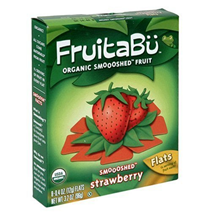 FruitaBü Organic Smoooshed Fruit Rolls Price:
FruitaBü Organic Smoooshed Fruit Rolls Price:
Where to buy: You can find them in natural food stores and many supermarkets 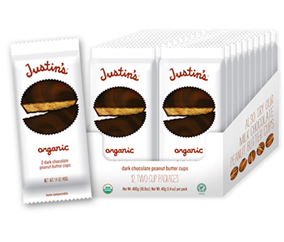 Justin’s Nut Butter Peanut Butter Cups (with milk or dark chocolate)
Justin’s Nut Butter Peanut Butter Cups (with milk or dark chocolate)
Price: $1.50-$1.59 per package (of 2 cups)
Where to buy: These are available at most Whole Foods Markets and online.
Newman’s Own Organics Peanut Butter Cups (with milk or dark chocolate)
Price: $1.50-$1.80 per package (of 3 cups)
Where to buy: Whole Foods Markets, as well as other retailers and stores. 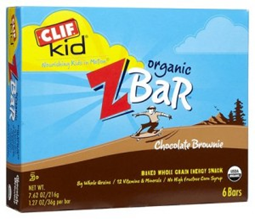
CLIF Kid Organic ZBars Price: $.69 each Where to buy: Trader Joe’s and many grocery stores 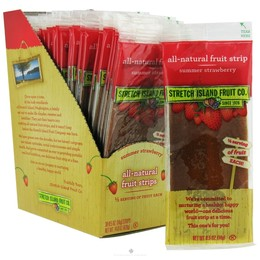 Stretch Island Organic Fruit Leather Price: $16.49 for a 48-count box Where to buy: You can find them in natural food stores and many supermarkets, or online.
Stretch Island Organic Fruit Leather Price: $16.49 for a 48-count box Where to buy: You can find them in natural food stores and many supermarkets, or online.  Newman’s Own Organics Peppermint Cups and Organics Caramel Cups Price: $1.50-$1.80 per package (of 3 cups)
Newman’s Own Organics Peppermint Cups and Organics Caramel Cups Price: $1.50-$1.80 per package (of 3 cups)
Where to buy: Whole Foods Markets and large numbers of other retailers and stores.
Sun Cups Caramel or Almond Butter Chocolate Cups
Price: $1.90-$1.99 per package (of 2 cups; $1.99 for a package or $37.99 for variety pack of 20 packages)
Where to buy: Find a Store. Funky Monkey Freeze-Dried Organic Fruit Snacks Price: $26 for a pack of 12 Where to buy: Target, Whole Foods, and a variety of other grocery stores El Rey Chocolate Squares
Price: 13-25 cents per square ($6.95 for 28 squares or $25.00 for 200 squares)
Where to buy: At retailers nationwide or online.
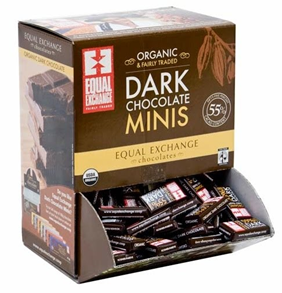 Equal Exchange Dark Chocolate (55%) Minis
Equal Exchange Dark Chocolate (55%) Minis
Price: 17-20 cents per mini ($29.75 for approximately 150 minis, or $148.75 for 888)
Where to buy: Online or select health food stores
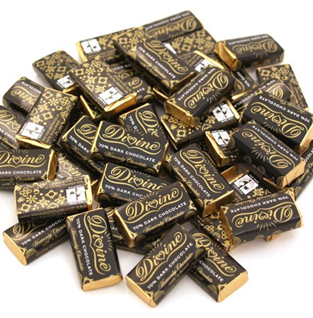 Divine 70% Dark Chocolate Bites
Divine 70% Dark Chocolate Bites
Price: 27-30 cents per piece
Where to buy: Online or select health food stores
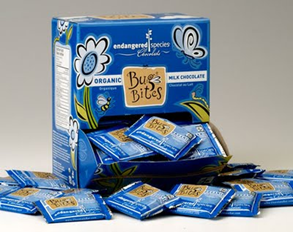 Endangered Species Milk or Dark Chocolate Halloween Treats or Bug Bites
Endangered Species Milk or Dark Chocolate Halloween Treats or Bug Bites
Price: 28-29 cents per Halloween Treat and 53 cents per Bug Bite
Where to buy: Online or select health food stores
 Askinosie itty Bars
Askinosie itty Bars
Price: 85 cents per bar ($127.50 for 150 itty Bars, a variety of single origin chocolates of high cacao content)
Where to buy: Online or select health food stores
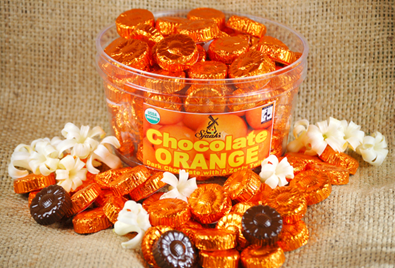 Sjaak’s Halloween Orange Bites
Sjaak’s Halloween Orange Bites
Price: 35-43 cents per piece ($9.95 for a 6 oz bag or $33.00 for a 1.5lb tub, about 93 pieces)
Where to buy: Online or select health food stores
 Sweet Earth Trick or Treat Chocolates,
Sweet Earth Trick or Treat Chocolates,
Price: 50 cents per piece ($25.00 for a bag of 50 or $50.00 for a bag of 100)
Where to buy: Online or select health food stores
Sun Cups Sunflower Chocolate Cups
Price: $1.90-$1.99 per package (of 2 cups; $1.99 for a package or $37.99 for variety pack of 20 packages)
Where to buy: Online or Find a Store.
 Earth Balls from Natural Candy Store Cost: $8.39 for 35 balls. Where to buy: Online or select health food stores.
Earth Balls from Natural Candy Store Cost: $8.39 for 35 balls. Where to buy: Online or select health food stores. 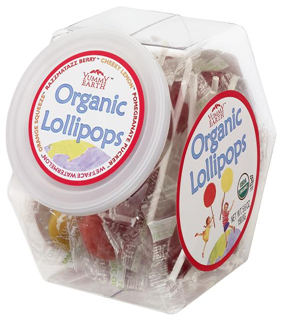 Yummy Earth’s All-Organic Lollipops Cost: $6 for 50 lollipops Where to buy: Select grocery stores
Yummy Earth’s All-Organic Lollipops Cost: $6 for 50 lollipops Where to buy: Select grocery stores
{****} Activist: do reverse trick-or-treating
If you really want to advocate this Halloween, consider doing reverse trick-or-treating, where you give out fair-trade chocolate and a pamphlet as you go door-to-door. Individual participants or families can participate by visiting www.reversetrickortreating.org. I do realize that fair-trade candy is quite a bit more expensive than the mainstream alternative. But again, I think we have to keep in mind – would we pay less for a product if a child was being abused to make it right in front of us? I’ve also heard people express concern that children will be disappointed with fair-trade chocolate. In my house, my kids are equal-opportunity chocolate lovers. Quite honestly, kids who stop by my house should be lucky they aren’t getting raisins and pencils, because I’ve so been THAT mom before. But if we’re making our purchasing decisions because we’re scared that a bunch of American kids might be disappointed because they can’t gorge themselves on chocolate made by children in Africa . . . there might be a problem with our priorities.
How do you boycott mainstream chocolate if the neighbors are passing it out while kids trick-or-treat?
This is a hard question to answer. Inevitably, some of our neighborhood homes will be passing out mainstream chocolate as we are trick-or-treating. I haven’t yet decided what our family will do. On the one hand, the candy is already purchased, so the only statement we would be making would be to our neighbors. And I know from the proliferation of nasty comments on my last post that people get all bent out of shape when they are told that something they love may be unethical. (I’ve since deleted the comments, but I got more hateful comments on that post than any I’ve ever written – everything from people accusing me of lying to calling me fat to telling me I don’t care about kids in the U.S.). I’m not sure that a drive-by trick-or-treating moment is the time to educate, and it would definitely put people on the defense. At the same time, Jafta is very educated on the issue and I can only imagine that he will be vocal about it, and I don’t want to stifle him, either. I haven’t yet decided what we will do. What about you? What will you be passing out this Halloween? And how will you approach it if you decided to boycott mainstream chocolate but the kids bring it home?
